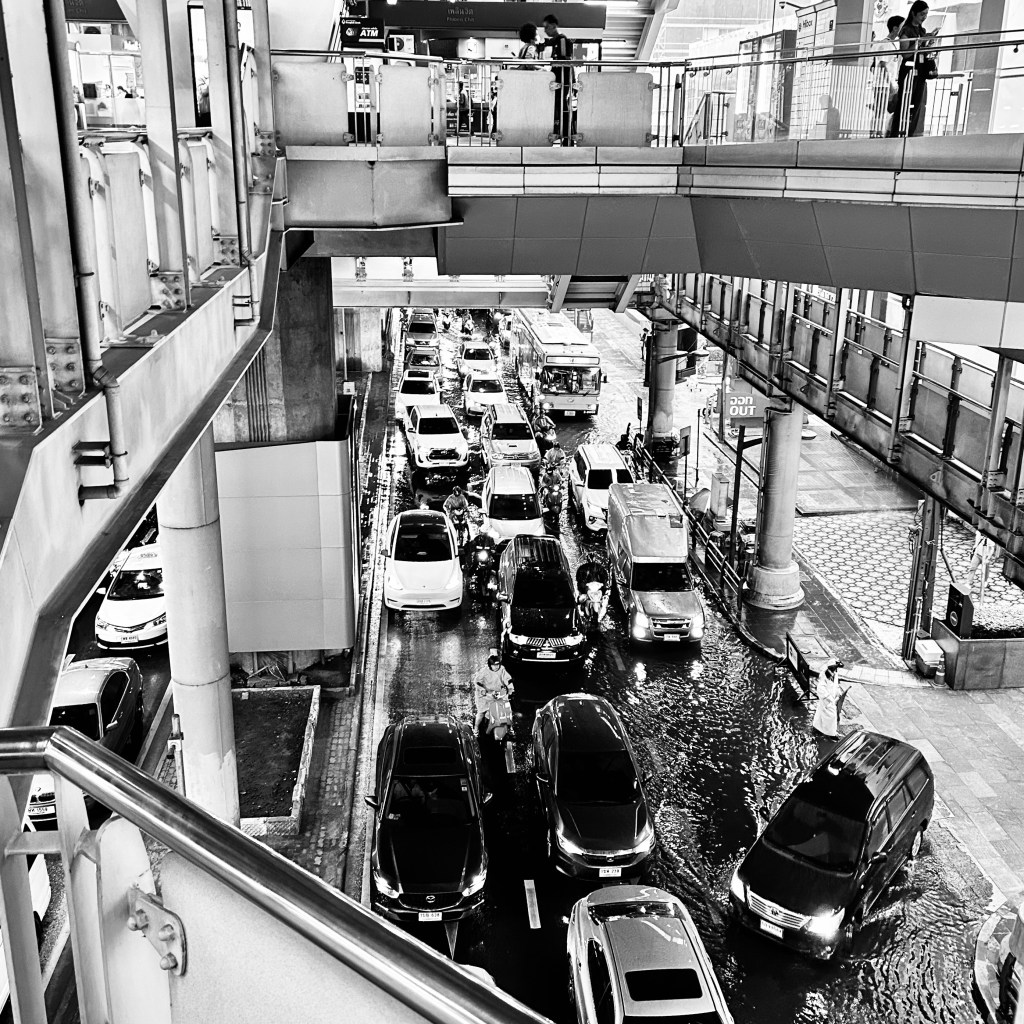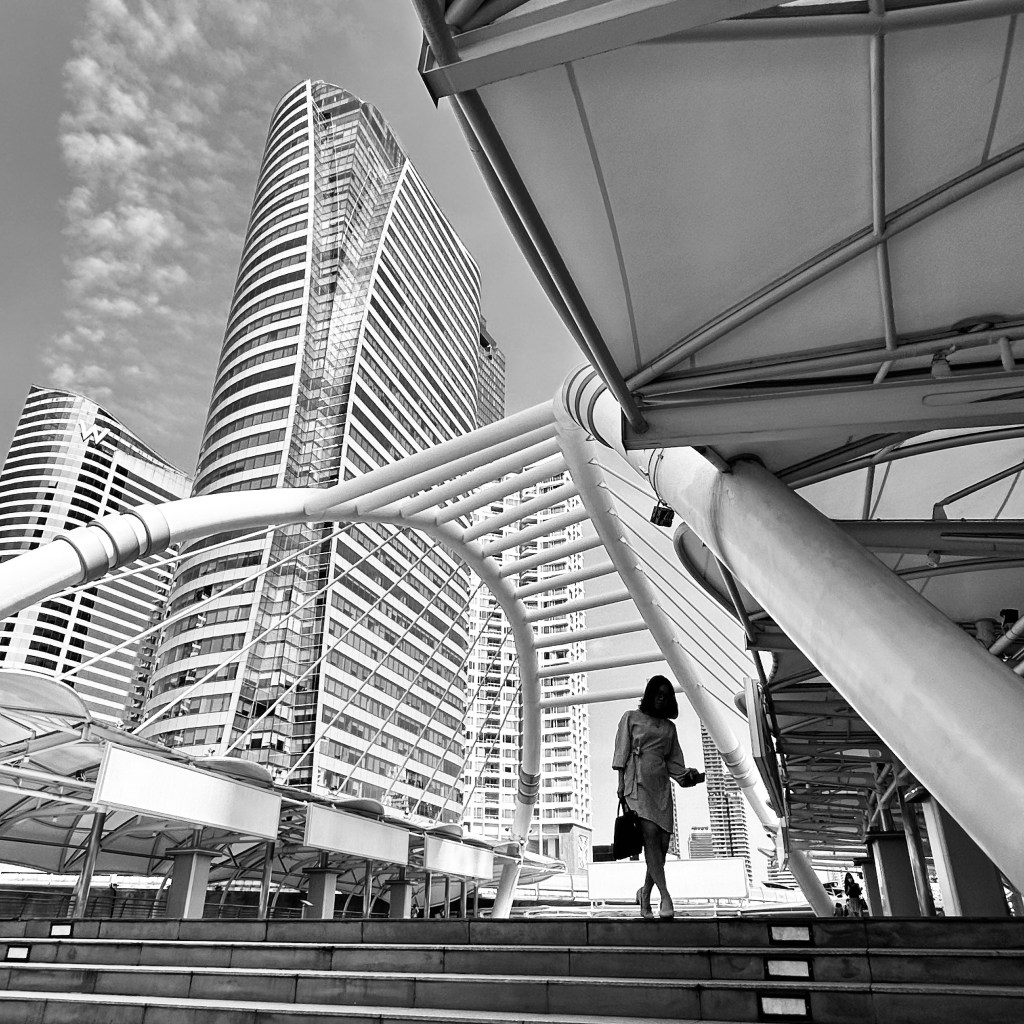Bangkok is many things in the minds of many millions of people, but what it is not is a city known for being ‘walkable’. Over the past two decades, the city’s increasingly sophisticated transport system has been striking back against its arch-enemy — traffic, nurturing a growing population of incidental skywalkers.
“A long time ago in a galaxy far, far away….”. Hold on, I didn’t write that. Let’s try that again. Not so long ago, in the Milky Way galaxy, in a city I call home — Bangkok — if someone had asked me “What’s the T?” on how to get around Thailand’s capital, I would reply in no uncertain terms with three “T’s” of my own: Tuk-tuks, Taxis and Traffic. For decades, this city’s unofficial motto was “hurry up, and wait.” And wait we would, for hours on end, in pollution-laced humidity, sometimes inundated with the occasional oh-boy, knees-up, shoes-off, flash flood. But as we all know, a little over two decades ago came along the Skytrain, followed by the subway (which now, in some areas, pops above-ground like a Skytrain), then the airport express (which looks like a Skytrain but is operated by the State Railway), and most recently the Monorail (which looks like a slimmed-down Skytrain, but confusingly, is managed by the subway), all of which brought along its own alphabet soup of acronyms (BTS, MRT, SRT) and an equally bewildering lack of cohesion, payment connectivity and sometimes, even an actual, physical connection. We all love to moan about it, but let’s be honest: this city has been transformed for the better because of it, and chaotic as it has been, engineering it all into existence in a town that has never been hailed as a paragon of urban planning, in a country beset with coups and coalition governments that meet and greet each other like they’re at a speed dating event, has been nothing short of a miracle. This is, after all, Thailand. We embrace chaos here and secretly love it; if we didn’t, we’d all have moved to Singapore long ago.
Depending on who you ask, where you must go, and what time you travel, traffic can still feel (and is) unbearable. But if you are like me and long ago shed yourself of the burden of car ownership, I can tell you that Bangkok is increasingly one of Southeast Asia’s most accessible cities. It’s been a long time since I was last held hostage by rush hour. I know my opinion is pegged to one key fact: I happen to live near a Skytrain station, and for the most part, everywhere I usually need to get to is also now near enough to a Skytrain/Subway/Monorail station. A fact which in the context of this city, still comes as a surprise to those who live here. What used to seem like a privilege is now becoming commonplace for millions of the city’s inhabitants as the network of modern transport spreads its tentacles across the city, followed by the unrelenting rise of sky-piercing condominiums at every station, even on the furthest outreaches of the city. That much is self-evident, as Bangkok continues to bulldoze and crane itself outward, literally ‘cementing’ its status as a mega-city. But what is less hailed, less talked about, is another incidental aspect of this triumph of transport over traffic… the Skywalk.





Spanning intersections, caressing the curves of roundabouts, shadowing the underbelly of Skytrain tracks, draped alongside or running in and out of ever-new residential and retail developments like modernistic metal bunting, crisscrossing canals and waterways, sometimes morphing into full-scale plazas, the Skywalk has become a ubiquitous part of getting around Bangkok. Every day, elevated battalions of the city’s urban stormtroopers (myself included) navigate this network of suspended walkways to and fro. From meetings to meals, from dates to dos. It’s so much a part of my life now that I sometimes forget how remarkable or prevalent it is. Until, of course, I come across the equally formidable battalions of invading tourists who never fail to annoyingly stop mid-step to take a photo, a selfie, a wefie, a live stream, or whatever it is that they do to capture their increasingly photogenic lives. Until that is, I also stop mid-step and do the same thing myself. When did Bangkok become one of the most photographed cities on the planet? I’d argue it happened around the same time Skywalks began to spread across this city and gave people vantage points they never had before for taking photos.
Skywalks shelter, buffer, quicken, ease, abut and abate our days from the harshness of pavement-level reality. The term ‘above the fray’ comes to mind. The oppressive heat somehow feels less so when you’re elevated, with cross-flow breezes. I write this from first-hand knowledge. For some people, it is now possible to wake up in the morning and travel from home to work, go shopping, eat out, and head to and from both of Bangkok’s airports, go for drinks, even head to the river without barely treading their leather-loafered feet on street-level sidewalks. While that isn’t everyone’s life, it is nowadays, quite a lot of people’s lives. And that is pretty remarkable. Living here, we all famously complain about how maddeningly manic it is and how nothing works (even though they do) or how things work sometimes without making sense, which does in fact, make sense. But lately, I catch myself walking as I do every day on the Skywalk and think, wow, this works… this makes sense. Which, as anyone who lives in Bangkok knows, isn’t something we say too often.
There are, without a doubt, downsides as well. Skywalks have altered the city’s streetscapes. Street vendors, when they aren’t being harangued by the city’s ever-shifting clean street policy, are left with far less foot traffic. There are moments when I realise that the Skywalk serves as its own upstairs-downstairs class system in a society already rife with class prejudices, filled with the haves and the have-nots, as I walk not merely metaphorically, ‘above it all’. Some businesses that have not, or could not, or did not invest in linking their buildings with Skywalks have realised to their detriment that footfall has shifted. Some malls and office buildings have had to completely reorganise their internal layout because what used to be the main ground floor entrance has become a dead space, and the main point of entry now is the link to the Skywalk. New developments have taken great lengths to design ever more welcoming entry points from these elevated entrances.



Like any city worth a flight, Bangkok has its fair share of photogenic backdrops. The Temple of Dawn comes to mind, the Grand Palace, of course, and so on. But if you’re like me and scroll through IG feeds far more often than I like to admit to — of course, you’re like me. Otherwise, you would be reading this blog. You’ll increasingly notice that the Skywalk is becoming one of the defining visual clues in photos that tell people, “Oh, that’s Bangkok!” Ask anyone of twink-pop sensation Troye Sivan’s 14.9 million IG followers, and they’ll let you know right away that they recognise Bangkok’s most eye-catching Skywalk at the Sathorn-Chongnonsi intersection as he and his sultry crew danced their way in the steaming, neon-tinged night, in his latest music video, filmed just the other day.
People say a lot about Bangkok, and a lot of it is good. Twenty million visitors a year would probably agree. But one thing I’ve never heard is, “Oh, Bangkok, that’s a good walking city.” And that’s likely to be the case for some time. Still, suppose you’re savvy enough to know that this city’s transport system is now, even to the surprise of the people who live here, one of Southeast Asia’s best, and you’re savvy enough to try to orient your movements based on where the Skytrain/Subway/Monorail goes. In that case, you’ll also come to enjoy seeing this city from its Skywalks, and before you even realise it, you will learn you can spend days and days here, walking about quite easily, in one of the most exciting, confronting, confounding, fantastic cities on the planet. Does that make Bangkok a walking city? No. However, more and more, it is becoming a city inhabited by millions of Skywalkers, whether they realise it or not.
And that… makes this city a more walkable city. Until that is, when those pesky freak monsoon downpours turn every surface that isn’t elevated into dark, murky tributaries to the Chao Praya River, and you realise where you’re going requires you to descend the stairs from the Skywalk. Well then?
May the force be with you.


Leave a comment